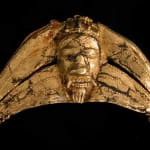Baule Gold Head-Shaped Pendant, 20th Century CE
Gold
3.875 x 2.5
PF.5814
Some of the finest African gold castings are pendants in the form of a human head. In literature, they are often referred to as “mask,” quite wrongly since they have...
Some of the finest African gold castings are pendants in the form of a human head. In literature, they are often referred to as “mask,” quite wrongly since they have no known association with masks or masking cults. The Baule themselves simply identify them as “heads” or “human heads.” Generally these pendants depict a male face, with beard and small mustaches, and often with elaborate hairstyles and facial scarifications. This pendant is a perfect example, demonstrating the curled moustache and braided beard as well as the ritual scarification along the temples of his forehead. These gold pendants were worn, both by women and men, as ornaments attached to the hair or suspended from a necklace. Several loopholes attached to the top and sides of this pendant attest to this fact. Such a precious ornament was generally regarded as a family heirloom and past down from generation to generation. The faces themselves might depict portraits either of friends and lovers or deceased ancestors and past kings, although this is unclear. This pendant is of a type originating in the lagoon region where the pendant face has been superimposed above a semicircular arch said to represent either a crescent moon or the horns of a ram. The beauty of gold is universally appreciated. This precious metal has been carved and molded into even more precious ornaments in cultures as diverse as Ancient Greece and Rome, the civilizations of Pre-Columbian South America, and the tribes of Western Africa. This gold pendant is more than just an ornament symbolizing the wealth of the wearer; it is a reminder of the greater universal appreciation of all things rare, precious, and beautiful.



